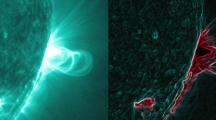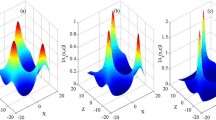Abstract
The solar corona, modelled by a low β, resistive plasma slab sustains MHD wave propagations due to footpoint motions in the photosphere. The density, magnetic profile and driver are considered to be neither very smooth nor very steep. The numerical simulation presents the evolution of MHD waves and the formation of current sheet. Steep gradients in slow wave at the slab edges which are signature of resonance layer where dissipation takes place are observed. Singularity is removed by the inclusion of finite resistivity. Dissipation takes place around the resonance layer where the perturbation develops large gradients. The width of the resonance layer is calculated. The thickness of the Alfvén resonance layer is more than that of the slow wave resonance layer. Attempt is made to distinguish between slow and Alfvén wave resonance layers. Fast waves develop into kink modes. As plasma evolves the current sheets which provide the heating at the edges gets distorted and fragment into two current sheets at each edge which in turn come closer when the twist is enhanced.
Similar content being viewed by others
References
Barnes, A. and Hollweg, J.V.: 1974, J. Geophys. Res. 79, 2302.
Cadez, V.M. and Ballester, J.L.: 1994, Astron. Astrophys., in press.
Chen, L. and Hasegawa, A.: 1974, Phys. Fluids 17, 1399.
Chiu, Y.T. and Wentzel, D.G.: 1972, Astrophys. Space Sci. 16, 465.
Choe, G.S. and Lee, L.C.: 1992, Sol. Phys. 138, 291.
Choudhuri, A.R., Auffret, H. and Priest, E.R.: 1993a, Sol. Phys. 143, 49.
Choudhuri, A.R., Dikpati, M. and Banerjee, D.: 1993b, Astrophys. J. 413, 811.
De Bruyne, P. and Hood, A.W.: 1993, Sol. Phys. 147, 97.
Erdélyi, R. and Goossens, M.: 1994, Astrophys. Space Sci. 213, 273.
Goedbloed, J.P.: 1983, Lecture Notes on Ideal Magnetohydrodynamics, Rijnhuizen Report 83-145, Nieuwegein, The Netherlands.
Goossens, M.: 1991, in: E.R. Priest and A.W. Hood (eds.), Advances in Solar System Magnetohydrodynamics, Cambridge Univ. Press, Cambridge, p. 137.
Goossens, M., Ruderman, M. and Hollweg, J.V.: 1995, Sol. Phys. 157, 75.
Grossman, W. and Smith, R.A.: 1988, Astrophys. J. 332, 476.
Hollweg, J.V.: 1981, Sol. Phys. 70, 25.
Hollweg, J.V.: 1990, Comp. Phys. Rep. 12, 205.
Hollweg, J.V.: 1992, Astrophys. J. 389, 731.
Ionson, J.A.: 1978, Astrophys. J. 226, 650.
Kaburaki, O. and Uchida, Y.: 1971, Publ. Astron. Soc. Jpn. 23, 405.
Kapparaff, J.M. and Tataronis, J.A.: 1977, J. Plasma Phys. 18, 209.
Karpen, J.T., Antiochos, S.K. and DeVore, C.R.: 1991, Astrophys. J. 382, 327.
Mett, R.R. and Taylor, J.B.: 1992, Phys. Fluids 4, 73.
Murawski, K., DeVore, C.R., Parhi, S. and Goossens, M.: 1996, Planet Space Sci. 44, 253.
Pandey, B.P., Avinash, K., Sen, A. and Kaw, P.K.: 1995, Phys. of Plasmas 2, 629.
Parhi, S. and Lakhina, G.S.: 1994, Earth, Moon and Planets 64, 107.
Parhi, S., De Bruyne, P., Murawski, K., Goossens, M. and DeVore, C.R.: 1996, Sol. Phys., 167, 181.
Poedts, S., Goossens, M. and Kerner, W.: 1990, Comp. Phys. Commun. 59, 95.
Poedts, S. and Kerner, W.: 1992, J. Plasma Phys. 47, 139.
Rickard, G.J. and Priest, E.R.: 1994, Sol. Phys. 151, 107.
Sakurai, T., Goossens, M. and Hollweg, J.V.: 1991a, Sol. Phys. 133, 227.
Sakurai, T., Goossens, M. and Hollweg, J.V.: 1991b, Sol. Phys. 133, 247.
Steinolfson, R.S.: 1991, Astrophys. J. 382, 677.
Steinolfson, R.S. and Davilla, J.M.: 1993, Astrophys. J. 415, 354.
Tataronis, J. and Grossman, W.: 1973, Z. Phys. 261, 203.
Uchida, Y. and Kaburaki, O.: 1974, Sol. Phys. 35, 451.
Wentzel, D.G.: 1974, Sol. Phys. 39, 129.
Author information
Authors and Affiliations
Rights and permissions
About this article
Cite this article
Parhi, S., Pandey, B., Goossens, M. et al. Mhd Study of Coronal Waves: A Numerical Approach. Astrophysics and Space Science 250, 147–162 (1997). https://doi.org/10.1023/A:1000444410913
Issue Date:
DOI: https://doi.org/10.1023/A:1000444410913




